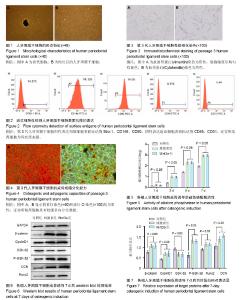| [1] Pihlstrom BL, Michalowicz BS, Johnson NW. Periodontal diseases. Lancet. 2005;366(9499):1809-1820.[2] Seo BM, Miura M, Gronthos S, et al. Investigation of multipotent postnatal stem cells from human periodontal ligament. Lancet. 2004;364(9429): 149-155.[3] Zhu W, Liang M. Periodontal ligament stem cells: current status, concerns, and future prospects. Stem Cells Int. 2015;2015:972313.[4] 李微,张博,张雨薇,等.雌激素调节骨代谢作用的研究进展[J]. 中国骨质疏松杂志, 2017, 23(2):262-266.[5] Nguyen HT, von Schoultz B, Nguyen TV, et al. Sex hormone levels as determinants of bone mineral density and osteoporosis in Vietnamese women and men. J Bone Miner Metab. 2015;33(6):658-665.[6] Baccaro LF, Conde DM, Costa-Paiva L, et al. The epidemiology and management of postmenopausal osteoporosis: a viewpoint from Brazil. Clin Interv Aging. 2015;10:583-591.[7] Makker A, Singh MM, Mishra G, et al. Relationship between bone turnover biomarkers, mandibular bone mineral density, and systemic skeletal bone mineral density in premenopausal and postmenopausal Indian women. Menopause. 2012;19(6):642-649.[8] 李洪亮,司家文,沈国芳.骨代谢过程中雌激素的影响与作用[J]. 中国组织工程研究, 2015, 19(7):1077-1081.[9] Pan F, Zhang R, Wang G, et al. Oestrogen receptors are involved in the osteogenic differentiation of periodontal ligament stem cells. Biosci Rep. 2011;31(2):117-124.[10] Cai C, Yuan GJ, Huang Y, et al. Estrogen-related receptor α is involved in the osteogenic differentiation of mesenchymal stem cells isolated from human periodontal ligaments. Int J Mol Med. 2013;31(5):1195-1201.[11] Liang L, Zhou W, Yang N, et al. ET-1 Promotes Differentiation of Periodontal Ligament Stem Cells into Osteoblasts through ETR, MAPK, and Wnt/β-Catenin Signaling Pathways under Inflammatory Microenvironment. Mediators Inflamm. 2016;2016:8467849.[12] Wei F, Yang S, Guo Q, et al. MicroRNA-21 regulates Osteogenic Differentiation of Periodontal Ligament Stem Cells by targeting Smad5. Sci Rep. 2017;7(1):16608.[13] 杨瑞莉,余婷婷,周彦恒. TGF-β对牙周膜干细胞性能的调节作用[J]. 临床口腔医学杂志,2017,33(2):84-86,87.[14] Peifer M, Polakis P. Wnt signaling in oncogenesis and embryogenesis--a look outside the nucleus. Science.2000;287(5458):1606-1609.[15] Tornero-Esteban P, Peralta-Sastre A, Herranz E, et al. Altered Expression of Wnt Signaling Pathway Components in Osteogenesis of Mesenchymal Stem Cells in Osteoarthritis Patients. PLoS One. 2015;10(9):e0137170.[16] Zhang J, Zhang J, Qi C, et al. Activation of Wnt3α/β-catenin signal pathway attenuates apoptosis of the cerebral microvascular endothelial cells induced by oxygen-glucose deprivation. Biochem Biophys Res Commun. 2017;490(2):71-77.[17] 孙瑾. 牙周病的危害及预防保健[J]. 中国组织工程研究, 2014,18(b12):154.[18] Heitz-Mayfield LJ, Lang NP. Surgical and nonsurgical periodontal therapy. Learned and unlearned concepts. Periodontol 2000. 2013;62(1):218-231.[19] 苗雷英,孙卫斌. 牙周组织工程研究进展[J]. 医学研究生学报, 2016, 29(1): 3-9.[20] Fernandes G, Yang S. Application of platelet-rich plasma with stem cells in bone and periodontal tissue engineering. Bone Res. 2016;4:16036. [21] Ashri NY, Ajlan SA, Aldahmash AM. Dental pulp stem cells. Biology and use for periodontal tissue engineering. Saudi Med J. 2015;36(12): 1391-1399.[22] Zhu W, Liang M. Periodontal ligament stem cells: current status, concerns, and future prospects. Stem Cells Int. 2015;2015:972313. [23] Städeli R, Hoffmans R, Basler K. Transcription under the control of nuclear Arm/beta-catenin. Curr Biol. 2006;16(10):R378-385.[24] Willert K, Jones KA. Wnt signaling: is the party in the nucleus. Genes Dev. 2006;20(11):1394-1404.[25] Clevers H, Nusse R.Wnt/β-catenin signaling and disease. Cell. 2012; 149(6):1192-1205.[26] Song L, Liu M, Ono N, et al. Loss of wnt/β-catenin signaling causes cell fate shift of preosteoblasts from osteoblasts to adipocytes. J Bone Miner Res. 2012;27(11):2344-2358.[27] Chen LJ, Hu BB, Shi XL, et al. Baicalein enhances the osteogenic differentiation of human periodontal ligament cells by activating the Wnt/β-catenin signaling pathway. Arch Oral Biol. 2017;78:100-108.[28] 伍燕,邓超,杨琨,等.糖基化终末产物对人牙周膜干细胞骨向分化过程中的Wnt经典信号通路研究[J]. 华西口腔医学杂志, 2015, 33(6):627-632.[29] Jeoung JY, Nam HY, Kwak J, et al. A decline in Wnt3a signaling is necessary for mesenchymal stem cells to proceed to replicative senescence. Stem Cells Dev. 2015;24(8):973-982.[30] 潘央央,吴红崑.雌激素对绝经后妇女牙槽骨吸收的影响机制[J]. 国际口腔医学杂志, 2011, 38(2):174-176.[31] Takahashi O, Yoshihara A, Nakamura K, et al. Association between periodontitis and systemic bone mineral density in Japanese community-dwelling postmenopausal women. J Dent. 2012;40(4):304-311.[32] 梁敏,张劼,梁杏欢,等. 雌孕激素联合对去卵巢大鼠骨密度和骨形态计量学的影响[J]. 中国组织工程研究, 2010, 14(24):4380-4384.[33] 方玲娜,戴如春,盛志峰,等. 去卵巢大鼠胫骨和椎骨松质骨微结构的显微CT分析[J]. 中国骨质疏松杂志, 2011, 17(9):757-760.[34] Ames MS, Hong S, Lee HR, et al. Estrogen deficiency increases variability of tissue mineral density of alveolar bone surrounding teeth. Arch Oral Biol. 2010;55(8):599-605.[35] 李丹,钟良军.雌激素与牙周炎和绝经后骨质疏松的研究进展[J]. 牙体牙髓牙周病学杂志, 2008, 18(4):237-240.[36] Ou Q, Wang X, Wang Y, et al. Oestrogen retains human periodontal ligament stem cells stemness in long-term culture. Cell Prolif. 2017 Oct 12. doi: 10.1111/cpr.12396. [Epub ahead of print] |



